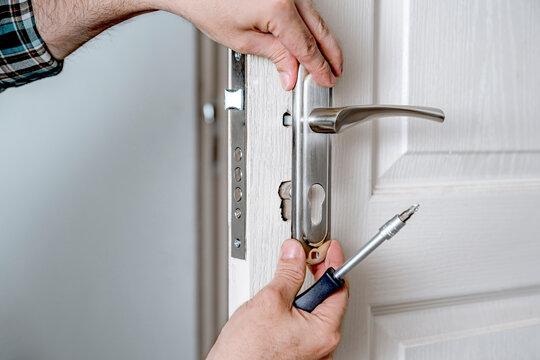Commercial Door Lock Regulations for Fire and Exit Doors

When it comes to the safety of your business premises, understanding and adhering to the regulations surrounding fire and emergency exit doors is crucial. These regulations are designed to ensure that, in the event of an emergency, occupants can exit the building quickly and safely.
Here’s our guide to the key aspects of commercial door lock regulations for fire and emergency exit doors for Australian standards.
Understanding Emergency Exit Door Requirements
Emergency exit doors play a critical role in any building's safety infrastructure. They must comply with strict standards to ensure they function properly during emergencies, such as fires or other hazardous situations. The Building Code of Australia (BCA) and Australian Standards provide clear guidelines on emergency exit door requirements and how these doors should be equipped and maintained.
Fire Exit Door Regulations
Fire exit doors are designed to facilitate the safe evacuation of occupants during a fire. According to the BCA’s fire exit door regulations, these doors must:
- Be fitted with a self-latching fire door lock that meets the Australian Standard AS1905.1.
- Have an automatic door closer that is also fire-rated, ensuring the door closes automatically after being opened.
- Not include any hold-open feature, as this can compromise the door’s ability to contain fire and smoke.
Emergency Exit Door Lock Regulations
The BCA D2.21 stipulates specific requirements for emergency exit doors, emphasising ease of use and accessibility:
- Single-Handed Operation: The lock must be operable with a single downward lever action. This ensures that individuals can easily open the door even in a panic.
- No Key Locking on the Inside: To prevent any obstruction during an emergency, key locking mechanisms are not allowed on the egress side of the door.
- Lock Height: Locks must be installed at a height between 900mm and 1100mm from the finished floor level. This ensures accessibility for all, including those with disabilities.
Fire Door Compliance: What You Need to Know
Fire door compliance is not just about meeting legal requirements; it's about ensuring the safety of everyone in the building. Fire doors are a critical barrier against spreading fire and smoke, buying valuable time for evacuation and emergency response.
Key Fire Door Lock Regulations
- Self-Latching Locks: Fire doors must be equipped with self-latching locks that comply with AS1905.1. These locks ensure the door remains closed when not in use, maintaining its integrity as a fire barrier.
- No Hold-Open Devices: Hold-open devices are not permitted to prevent accidental or intentional propping of fire doors.
- Fire-Rated Components: All hardware, including locks and door closers, must be fire-rated to match the door’s fire resistance level.
Compliance with the Disability Discrimination Act (DDA)
Ensuring that your building’s emergency exits are accessible to everyone, including those with disabilities, is a legal and moral obligation. The Australian Standard AS1428.1 outlines specific requirements for emergency exit doors to comply with the Disability Discrimination Act (DDA).
DDA Compliance for Emergency Exit Doors
- Lever Handles: Doors must be fitted with a DDA-compliant lever handle or push bar, making it easier for those with limited hand strength or dexterity to operate.
- Accessible Height: The lever handle must be positioned 35mm to 45mm from the door face, with a 20mm return on the lever to prevent the hand from slipping off.
Why Compliance Matters for Sydney Businesses
Compliance with fire door lock regulations and emergency exit door requirements means you avoid penalties while safeguarding lives. Local councils in Sydney require compulsory annual fire safety certificates, which include a thorough check of all emergency exits and fire doors. Non-compliance can result in hefty fines, legal liabilities, and, most importantly, increased risk to your employees and customers.
How Lost Key Locksmiths Can Help
At Lost Key Locksmiths in Sydney, we understand the complexities of fire door compliance and emergency exit door requirements. Our team of experienced and licensed locksmiths is here to ensure your business meets all Australian standards. We offer comprehensive services, including compliance assessments, installation, and maintenance of fire door locks and emergency exit doors.
Contact Lost Key Locksmiths today for reliable and professional service. Our commercial locksmith services are available all day, ensuring that your business’s safety is in expert hands.
For 24-hour locksmiths in Sydney, call us at +61 482095238 or contact us here.
Read More

What is Home security and how to increase it?
Home security isn't just about having a lock on your door anymore. With house robbery rates dropping 22.9% in NSW when proper security systems are in place, it's clear that understanding and implementing the right protection makes a real difference for your family's safety.
.jpeg)
Stranded and Stressed: What to Do During a Car Lockout
It's happened to the best of us. You race out the door, only to find the car securely locked and your keys… nowhere to be found. Panic sets in. You're locked out, stranded, and potentially facing a major inconvenience.

Tips for Securing Multi-Unit Residential Buildings
Security in multi-unit residential buildings is a paramount concern for property managers, HOA board members, and residents alike. With the rise of theft, vandalism, and trespassing, implementing robust security measures is crucial to ensure the safety and well-being of everyone in the building.





